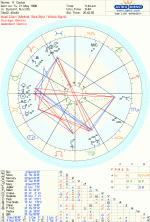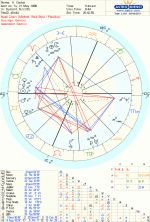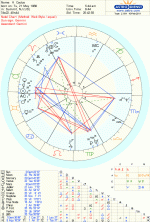dadsnook2000
My approach to chart deliniation
I do not always follow the same process steps in analyzing a chart. However, I do look at the following primary factors, often in the order given, although the sequence can vary depending upon what seems most important.
1) Angular planets; these are the power planets that tend to be most active and obvious in one's life.
2) Sun-Moon phase relationship; using Rudhyar's and Marc Robertson's eight phase approach to cycles.
3) Sun position by house.
4) Moon position by house.
5) Sun aspects to other planets, particularly hard aspects.
6) Moon aspects to other planets.
7) Angular planets and their aspects to other planets.
If the chart doesn't offer a theme that jumps out at me, I'll interrupt the above sequence and use six phase relationship patterns, these being:
* Sun-Moon for basic personality.
* Moon-Saturn for family conditioning and habits.
* Mercury-Jupiter for social interchange
* Venus-Mars for poise and sexual hangups.
* Jupiter-Saturn for the business of life and how it is conducted.
* Saturn-Uranus for opportunity, expression of individualism, excitement.
Further down the line, I'll sometimes look at planets in houses if I haven't done that as part of the primary explorations.
Signs are sometimes considered in a classical sense, but not often and only in natal, mundane or medical charts. As an extension of this, I don't often bother with rulerships and other classical approaches. Too distracting.
If I am doing a review of one's current life situation, I'll shortcut the natal chart, looking at the Sun and Moon positions and relationships, plus the six planet pairings in phase relationships. Then, I'll do a solar return and decide which dates in the year are important in terms of events or happenings that are important to the potential shown in the natal chart and solar return chart.
This may be useful to understand but do remember, Cactus, that the sequence depends upon having the skills to use this approach. In time, most astrologers develop their own individual approaches based on their success with certain types of charts and interpretive approaches. Just remember, whatever you do and use, it should be highly reliable. It is better to work with one or two tools that are highly reliable than a dozen or more that only work sometimes and which can leave you embarrassed and your client with confusion or doubt about your statements. Dave
I do not always follow the same process steps in analyzing a chart. However, I do look at the following primary factors, often in the order given, although the sequence can vary depending upon what seems most important.
1) Angular planets; these are the power planets that tend to be most active and obvious in one's life.
2) Sun-Moon phase relationship; using Rudhyar's and Marc Robertson's eight phase approach to cycles.
3) Sun position by house.
4) Moon position by house.
5) Sun aspects to other planets, particularly hard aspects.
6) Moon aspects to other planets.
7) Angular planets and their aspects to other planets.
If the chart doesn't offer a theme that jumps out at me, I'll interrupt the above sequence and use six phase relationship patterns, these being:
* Sun-Moon for basic personality.
* Moon-Saturn for family conditioning and habits.
* Mercury-Jupiter for social interchange
* Venus-Mars for poise and sexual hangups.
* Jupiter-Saturn for the business of life and how it is conducted.
* Saturn-Uranus for opportunity, expression of individualism, excitement.
Further down the line, I'll sometimes look at planets in houses if I haven't done that as part of the primary explorations.
Signs are sometimes considered in a classical sense, but not often and only in natal, mundane or medical charts. As an extension of this, I don't often bother with rulerships and other classical approaches. Too distracting.
If I am doing a review of one's current life situation, I'll shortcut the natal chart, looking at the Sun and Moon positions and relationships, plus the six planet pairings in phase relationships. Then, I'll do a solar return and decide which dates in the year are important in terms of events or happenings that are important to the potential shown in the natal chart and solar return chart.
This may be useful to understand but do remember, Cactus, that the sequence depends upon having the skills to use this approach. In time, most astrologers develop their own individual approaches based on their success with certain types of charts and interpretive approaches. Just remember, whatever you do and use, it should be highly reliable. It is better to work with one or two tools that are highly reliable than a dozen or more that only work sometimes and which can leave you embarrassed and your client with confusion or doubt about your statements. Dave




